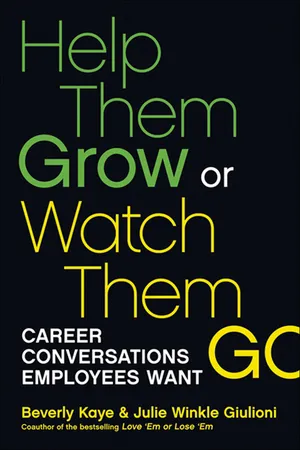![]()
1
Develop Me OR I’m History!
Spending 40-60-80 hours somewhere each week … I want it to mean something. I want to feel like I’m moving forward somehow. If I can’t grow here, I’ve gotta look elsewhere.
—an employee (perhaps yours)
The decision to assume a management role in today’s workplace comes with a front-row seat to some of the greatest business challenges of our time. Day in and day out, you must
Do more with less. It’s become cliché, but it permeates life at work. You’ve likely become a master at finding ways to reduce costs, time, and other resources below levels you never imagined were possible.
Meet ever-expanding expectations. Every quarter, you’re asked to do a little (or a lot) more. Bigger sales. Greater numbers of service interactions. More projects. Higher scores.
Continuously improve quality. Good enough isn’t. Given the competition in today’s global market, perfection is the standard—until it’s met and you have to do even better.
Deliver the next big thing. Most organizations believe that if they’re not moving forward, they’re sliding back. Innovation gets its picture on business magazine covers because it represents the promise of greater success.
And, no matter how long, hard, or smart you work, you can’t do all of this alone. Success depends upon tapping the very best that each employee has to offer and enabling the highest possible levels of engagement.
Study after study confirms that best-in-class managers—the ones who consistently develop the most capable, flexible, and engaged teams able to drive exceptional business results—all share one quality: they make career development a priority.
A “HISTORY” LESSON
Even during challenging economic times, your best and brightest have options. Failing to help them grow can lead employees to take their talents elsewhere. They become “history.” But what can be equally as damaging as this sort of talent drain are the employees who stay and become disengaged. Their bodies remain but their commitment has quit. In this way, history plays out, repeating itself over and over again in too many organizations.
So, if career development is a tool that can deliver productivity gains, expense reduction, quality improvements, innovation, and bottom-line results, why isn’t everyone using it?
DEFINING TERMS
Perhaps it’s frequently forgotten because the term career development strikes fear into managers’ hearts.
Whatever your answer, we’ll bet that ours is simpler. You see, many managers are intimidated by or steer clear of career development because they have a mistaken, convoluted, or overwhelming definition of the term.
So, try this definition on for size:
Career development
is nothing more than
helping others grow.
And nothing less.
Helping others grow can take a nearly unlimited number of forms. On one end of the continuum, you help employees prepare for and move to new or expanded roles in obvious and visible ways. But far more frequently, growth shows up on the other end of the continuum, in small, subtle ways that quietly create greater challenge, interest, and satisfaction in a job.
The problem is that too often career development evokes images of forms, checklists, and deadlines. And let’s be honest—you’ve got to address them to support the organization. But administrative details are not career development.
Instead, genuine and meaningful career development occurs through the human act of conversation.
Whether it’s a formal individual development planning (IDP) meeting or an on-the-fly connection, it’s the quality of the conversation that matters most to employees. That’s how they judge your performance and their development. That’s also how they make the decision to go or stay—or to stay and disengage.
So, if it really is as simple as just talking to people, then why isn’t career development a more common feature of the organizational landscape?
IMMOBILIZING MYTHS
Over the years, managers—by sharing oral history and spinning lore—have created and continue to propagate several myths. And these myths (read: reasons or excuses) keep them from having the very career conversations their employees want. Which are familiar to you?
Myth 1 — There is simply not enough time.
No one will argue that time is among the scarcest resources available to managers today. But let’s get real. You’re having conversations already—probably all day long. What if you could redirect some of that time and some of those conversations to focus on careers?
Myth 2 — If I don’t talk about it, they may not think about it and the status quo will be safe.
Why invite problems? Developing people could lead them to leave and upset the balance of your well-running department, right? Wrong. Employees have growth on their minds—whether you address it or not. Withholding these conversations is a greater danger to the status quo than engaging in them.
Myth 3 — Since employees need to own their careers, it’s not my job.
No one will argue that managers don’t own the development of their employees’ careers. Employees do. But that doesn’t mean that managers are completely off the hook. You have an essential role in helping and supporting others to take responsibility. And that role plays out in large part through conversation.
Myth 4 — Everyone wants more, bigger, or better: promotions, raises, prestige, power.
If you believe this one, then your employees all look like baby birds, their mouths always wide open, wanting to be fed. This image probably loses its appeal quickly even for doting bird parents—much less busy managers. But based upon our research, this image is patently inaccurate. When asked about what they want to get out of a career conversation with their managers, the number-one response from employees is “ways to use my talents creatively.”
Myth 5 — Development efforts are best concentrated on high potentials, many of whom already have plans in place.
This one’s a cop-out. You can indeed see a significant return on the development you invest in your high potentials. But they make up only about 10 percent of your population. You probably have another 10 percent of marginal performers who are on a very different kind of plan. But what about the 80 percent in between—the massive middle responsible for doing the bulk of the work? Imagine what even a small investment in their development might yield.
If you’re like most managers, a few of these myths likely make sense to you. Dog-ear or bookmark these pages and come back to them after you’ve completed the book. We predict that once you are introduced to a different way of looking at your role, you may also look at career development and these myths a little differently.
But, until then, remember this: growing the business means growing people. Forget that … and the rest is history.
![]()
2
Can We Talk?
I am realistic. I know your time is tight and that you’ve got lots of other priorities. My career probab...




